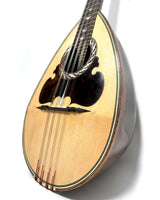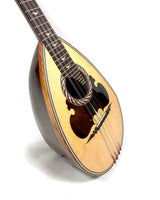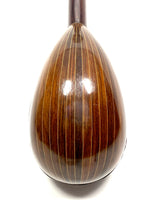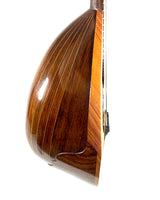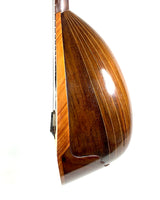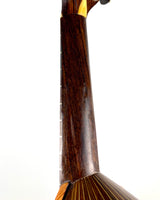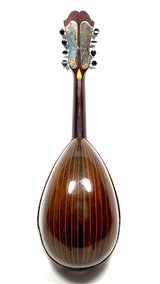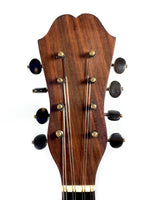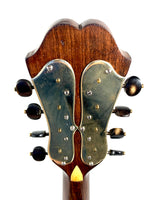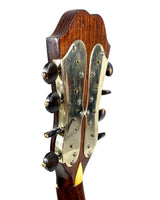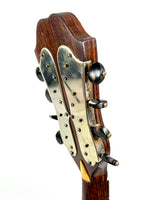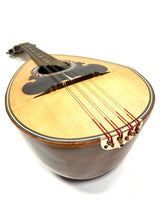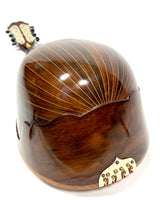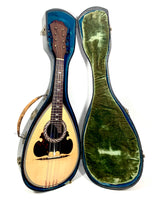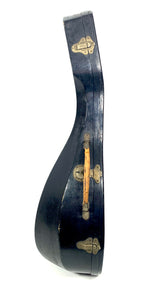Raffaele Calace
Raffaele Calace (Nicola Maria Calace) Concert Mandolin from 1902
Raffaele Calace, born in 1863 and died in 1934, was an Italian composer, performer, teacher and luthier who left an indelible mark on the history of the mandolin. His contribution to the evolution of this plucked string instrument is recognized as revolutionary.

Photo by Raffaele Calace.
(Source: www.alchetron.com)
Calace grew up in a musical family and began playing the mandolin at a young age. Endowed with exceptional talent, he quickly stood out for his technical skills and his sense of musical expression. However, he was not only a virtuoso, but also developed a deep interest in violin making.
At that time, the mandolin was mainly used as an accompanying instrument in musical ensembles. Calace set out to push the limits of the instrument by transforming it into a virtuoso instrument intended for soloists. He developed new playing techniques and explored the expressive possibilities of the mandolin.
But Calace didn't stop there. He also brought major innovations to mandolin violin making. He simplified the construction of the instrument, making its mass production easier. He also invented new variations of the mandolin, such as the mandolyra and the cantabile lute, which offered new sounds and musical possibilities.

Photo of Raffaele Calace depicted with a cantabile lute.
(Source: www.wikipedia.com)
Calace's impact on the mandolin was immense. His work helped elevate the instrument's status from a simple accompaniment to a respected solo instrument. His virtuosity and compositions also inspired many other musicians and composers to explore the possibilities of the mandolin.
Today, the mandolin manufacturing company founded by Raffaele Calace still exists, preserving its heritage and continuing to produce high-quality instruments. His influence on the mandolin and music in general remains undeniable, making him one of the most significant figures in the history of this instrument.
Here it is a concert mandolin which is offered for sale, a model still uncommon at the time.
It is almost certain that this mandolin was made largely by Nicola Maria Calace himself, despite the fact that it bears the label of Raffaele Calace who is said to have completed the mandolin himself. Indeed, certain distinctive characteristics, which correspond perfectly to a model made by Nicola Calace dated 1898.

Mandolin made by Nicola Maria Calace in 1898.
We clearly notice the concert key also present on this model, thicker than that of Raffaele, but also a classic Neapolitan head, a similar arrangement of the mother-of-pearl inlay of the rosette, the plate is similar to that present on the mandolin here offered for sale and finally, the desire to create an instrument that sounds its best with a beautiful spruce top
Nicola is the brother of Raffaele Calace, the other half of the famous "Fratelli Calace". The dating of this instrument coincides with the year in which the two brothers separated, around 1902.
Additionally, it is evident that this mandolin was designed to deliver a superb playing experience and sound. The use of a concert key, which was still very rare at the time, is rare and remarkable on Calace instruments from this period. Indeed, Raffaele Calace would adopt this practice almost a decade later.
In addition, the presence of a "classic" head, which was uncommon but notable in Calace's production, adds to its singular character.
This mandolin is therefore a rare instrument, of considerable historical interest in understanding its evolution, but it also has a particular importance in the evolution of the Calace factory.
Very careful in its construction, and refined in its decorations, this mandolin presents both the charm of an elegant instrument, a very interesting testimony in the brilliant Calace production, but also a well thought-out manufacturing designed to sound at its best.
Technical characteristics :
- Top: Spruce
- Back: 19 rib rosewood
- Neck: Rosewood veneer
- Fingerboard: Rosewood
- Width at nut: 28.5 mm
- Radius: Flat
- Frets: 24 frets
- Scale: 330 mm
- Profile: Neapolitan
- Pickguard: Tortoiseshell inlaid with a white mother-of-pearl drop
- Country of manufacture: Italy, Naples
- Year: 1902
- Finish: Natural
- Decorations: Horn buttons / Threads on the edge of the table and rosette / Rosette inlaid with complex patterns in white mother-of-pearl / Key markers inlaid with wave patterns in white mother-of-pearl / Iron marks on the table in the shape of a flower at the ends of the bridge
- Details: Top joint repaired according to the rules of the art / Wear of varnish on the handle / Very good state of conservation / Delivered in its period case
Like all our instruments, this mandolin has been completely restored, cleaned and adjusted in order to have optimal playing comfort.
It is mounted with Fisoma brand Supersolo model flat wound strings with extra light tension which presents a delicate touch and sound while respecting the tension constraints of the instrument.
With a delicate, balanced, harmonic-rich sound and good projection, this mandolin is an ideal instrument for all collectors and mandolinists.


